-
Find your fit
Let’s find the right tire for you.
-
Browse tires by
- Vehicle Type
-
Product Line
- Tire Use
Tire Safety Information
 WARNING!
WARNING!
TIRES MUST NEVER BE OPERATED IN EXCESS OF THEIR RATED SPEED LIMIT!
Exceeding the tire's speed capability will cause overheating of the tire and sudden tire failure, possibly leading to loss of vehicle control. All Toyo passenger, light truck, and truck tires have a maximum speed rating depending on size and type. Consult your tire dealer or contact Toyo Tires at 800-442-8696 if you are not sure about the maximum speed rating of your tires. Toyo Tire U.S.A. Corp. does not endorse the operation of any vehicle in an unsafe or unlawful manner. Obey all local speed limits. Tire speed ratings do not imply that a vehicle can be safely driven at the speed for which the tire is rated. Speed ratings are based on laboratory tests that relate to performance on the road, but are not applicable if tires are underinflated, overloaded, worn out, damaged or altered.
WARNING!
USE AND INSTALLATION OF WINTER (SNOW) TIRES
Winter driving presents special challenges for vehicle handling. The use of winter tires, studs, and/or chains, while improving snow traction performance, requires additional caution with regard to braking, cornering, and speed. The use of snow tires may reduce the vehicle's handling and braking capability. It is important to drive with care not only on snow and ice, but on dry and wet roads as well. Toyo recommends that snow tires be installed in matched, sets of four. This also applies for studded winter tires. When snow tires of a lower speed rating compared to the original tires are installed, the vehicle's speed capability is reduced. Follow all recommendations in the vehicle owner's manual regarding the use of winter tires. Consult your tire dealer for information regarding seasonal restrictions for stud usage.
WARNING!
PROPER SELECTION OF REPLACEMENT TIRES
Replacement tires for any vehicle must be of a size, load range, and load capacity (by inflation) that are capable of supporting the load of the vehicle's originally installed (O.E.) tires. Failure to install tires with adequate load capacity will result in tire fatigue and sudden tire failure leading to possible loss of control or an accident.
IMPORTANT! Refer to the vehicle owner's manual for any specific safety advice regarding the application of replacement tires.
WARNING!
TIRE AND RIM MATCHING
NEVER MOUNT 16" RIM DIAMETER TIRES ON A 16.5" DIAMETER RIM! Any attempt to mount a 16" rim diameter tire on a 16.5" rim diameter will result in an explosion of the tire/rim assembly that can cause severe personal injury or death. Prior to mounting any 16" rim diameter tires, always check the rim/wheel identification stamp to verify the correct rim diameter. Always check the tire size molded onto the sidewall. NEVER exceed 40 psi when seating the beads on rims.
Warning for additional sizes – to avoid an explosion of the tire/rim assembly and personal injury or death:
- Never attempt to mount 22" rim diameter tires on any 22.5" diameter rim!
- Never attempt to mount 24" rim diameter tires on any 24.5" diameter rim!
WARNING!
REPLACEMENT TIRES FOR LIGHT TRUCKS – P-METRIC VS. LT-METRIC
Tire installers should exercise extreme caution when replacing tires on light trucks. LT type tires (e.g. LT265/75R16) may not offer adequate load capacity when replacing P-metric type tires (e.g. P265/75R16), depending on the vehicle's load requirements and the tire's load/ply rating. LT type tires require much higher air pressures to carry equivalent loads of P-metric tires.
If P-metric type tires are used to replace LT-metric tires, installers should verify the load requirement of the vehicle by checking the tire information placard. Always make sure that replacement tires offer equal or more load capacity (by inflation) compared to the originally installed tires.
If P-metric, or metric tires are intended to replace originally installed LT type tires, the load capacity of the P-metric tire is reduced by 9% at any inflation value. Consult manufacturer's load and inflation charts. Contact Toyo Technical Service with any tire replacement questions: 800 442 8696 (Pacific time), or 888-444-8696 (Eastern time).
ROLLOVER PROPENSITY OF LIFTED LIGHT TRUCKS
WARNING!
CONSUMER SAFETY ADVISORY FOR LIFTED LIGHT TRUCKS
Consumers should be aware that the installation of larger diameter tires, including off-road type tires, combined with modified suspensions (lift kits) for increased off-road ground clearance will adversely affect the handling and maneuverability characteristics of the vehicle compared with the factory-equipped (original) vehicle.
When vehicles, especially light trucks, are lifted, the center of gravity is heightened, thus making them more prone to rollover. Rollover propensity is further increased with full passenger and/or cargo loads. Other aspects of handling and maneuverability may also be affected by altering the original manufacturer's design.
As with any vehicle, extreme care must be used to prevent loss of control or rollover during sharp turns or abrupt maneuvers.
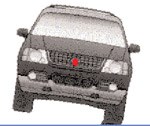

Always wear seat belts and drive safely, recognizing that reduced speeds and specialized driving techniques may be required.
The installation of larger tire and wheel combinations will reduce the effectiveness of anti-lock braking systems and increase stopping distance.
Failure to safely drive any vehicle equipped with a lift kit may result in an accident resulting in serious injury or death.
Do not drive a lifted vehicle unless you are familiar with its unique handling characteristics and are confident of your ability to maintain control under all driving conditions. Some modifications (and combinations of modifications) are not recommended and may not be permitted in your state. Consult your owner's manual, the instructions accompanying the lift kit, and state laws before undertaking any vehicle suspension modifications. You are responsible for the legality and safety of the vehicle you modify using lift-kit and tire modifications.
IMPORTANT SAFETY INFORMATION REGARDING TOYO TIRES
"Toyo Tires are designed and built with great care. Any tire, no matter how well constructed, can fail as a result of punctures, impact damage, improper inflation or other conditions resulting from use. Tire failures may create a risk of property damage or personal injury. To obtain the highest possible performance, they must be maintained properly.
IMPORTANT FACTORS IN TIRE CARE ARE:
- Proper Inflation Pressure
- Proper Suspension and Alignment
- Good Driving Habits
- Proper Vehicle Loading
- Regular Inspection + Tire Rotation
- Vehicle Condition
Refer to your vehicle owner's manual for additional tire safety and service advice.
TIRE PRESSURE BASICS
Tires can lose one psi (pound per square inch) per month under normal conditions.
Additionally, tires can lose one psi for every 10°F temperature drop. The combined effect of losing one psi per month over several months along with one psi for every 10°F temperature drop could add up to a serious "run low" condition.
Air pressure enables a tire to support the load, so proper inflation is critical.
It's impossible to determine whether tires are properly inflated just by looking at them. It is important to check your tires using an accurate tire gauge, which can be purchased at your tire dealer, auto supply store or other retailer. (See photo below.)
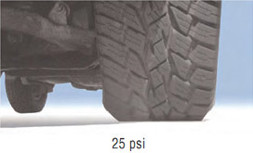
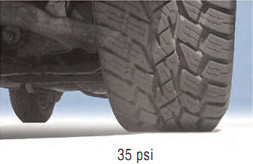
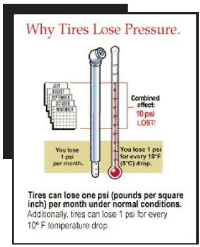
Look for the manufacturer's recommended air pressure listed on the Tire Information Placard of your vehicle's door edge, door post, glove box, or inside of trunk lid.
EXAMPLE
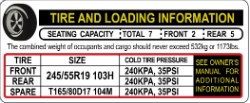
Underinflation can create an overload on tires. Check your air pressure every month to make sure it's up to specification, especially before long trips or when carrying extra weight.
DRIVING ON ANY TIRE THAT DOES NOT HAVE THE CORRECT INFLATION PRESSURE IS DANGEROUS!
Tire Inflation: Tire pressures, including the spare, should be checked at least once per month, before driving when the tires are cold (after the vehicle has been stopped for three hours or driven less than one mile). Do not reduce air pressure when tires are hot after being driven. Use a tire gauge to check pressure and maintain it at the level recommended by the vehicle manufacturer. If a tire loses more than one pound of air pressure per month, have it checked for leakage by your dealer. Proper inflation pressure is very important to tire life, safety, and vehicle handling; therefore, you should always maintain the correct inflation pressure in your tires according to your vehicle manufacturer's recommendation. In addition, your vehicle has a Tire Information Placard, which indicates the proper tire size and inflation pressure for your particular model vehicle. If you have changed the original size for an optional size, make sure to use the recommended air pressure provided by your authorized Toyo Tire dealer or contact Toyo Tires.
Driving on tires with too little air pressure is dangerous. Your tires will get overheated. This can cause a sudden tire failure that could lead to serious personal injury or death.
Air Pressure – Check Monthly. For accuracy, check your air pressure with a tire gauge when tires are cold (e.g., when your car has been parked overnight). Driving heats up tires and makes the reading incorrect. To check air pressure, follow these instructions below:
- Remove tire valve cap.
- Place the end of the tire gauge over valve.
- Press the tire gauge straight and firmly until the scale extends.
- If needed, add air and recheck pressure with the tire gauge.
- Replace valve caps.
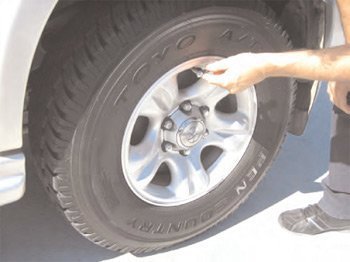
Underinflation or overloading creates excessive stresses and heat that will lead to tire failure. This could result in vehicle damage and/or serious injury or death. Proper inflation extends tire life and saves fuel. Maintain the inflation pressure listed on the tire information placard or the vehicle owner's manual.
Never inflate a tire unless it is secured to the vehicle or a tire mounting machine. Inflating an unsecured tire is dangerous. If it bursts, it could be hurled into the air with explosive force, resulting in serious personal injury or death.
RECOMMENDATIONS FOR SAFE TIRE INFLATION:
- Check tire inflation pressure (including spare) at least once a month and before every long trip.
- Check tires when they are cold; that is, before they have been run no more than a mile or after the vehicle has been parked overnight.
- If you must add air when your tires are hot, add four pounds per square inch (4 psi) (28 kPa) above the recommended cold air pressure. Recheck the inflation pressure when the tires are cold.
- Never release air from a hot tire in order to reach the recommended cold tire pressure. Normal driving causes tires to run hotter and air pressure to increase. If you release air when your tires are hot, you may dangerously under inflate your tires. If your tires lose more than one pound per square inch (1 psi) (14 kPa) per month, the tire, the valve, or wheel may be damaged. Consult your authorized Toyo Tire dealer for an immediate inspection.
- Remember to check your spare tire. Consult your vehicle owner's manual for the correct inflation and use of a "temporary use" spare tire.
- Use valve caps to keep cores clean, clear of debris and to help guard against air leakage.
REMINDER FOR VEHICLES EQUIPPED WITH LOW TIRE PRESSURE MONITORING SYSTEMS (TPMS)
Even if your vehicle is equipped with a low pressure monitoring system, you should check your tire's air pressure at least once per month when the tires are cold (example, after being parked overnight). Tire pressure warning systems are not a substitute for regular tire pressure maintenance. Read your vehicle's owner's manual regarding the operation of installed TPMS. Some tire pressure monitoring systems do not alert you until the tires are significantly under inflated, which may result in permanent tire damage and possible sudden tire failure. In the event that your tire low pressure monitoring system alarm is displayed, you should immediately pull over to a safe parking area and change the tire if necessary.
CHECK YOUR TIRES. DO NOT DRIVE ON A DAMAGED TIRE OR WHEEL!
Regular inspection of your tires for road hazard damage is critical. Inspect your tires for damage such as cuts, bulges, cracks, penetrations, unusual wear patterns, splits or bruises in the tread or sidewall areas, etc. Bumps or bulges may indicate a separation in the tire structure. Tire failure from road hazard damage can occur soon after the damage — a day, a week, or even months later.
Never drive on a tire if such conditions appear. Driving on a damaged tire is dangerous. A damaged tire can suddenly fail, causing serious personal injury or death. Do not attempt to dismount, mount or repair a tire yourself. See your Toyo dealer immediately if any condition is discovered.
IDENTIFYING DAMAGED TIRES:
- Tire Damage from Impacts: If your tire strikes an object such as road debris, curbs, potholes or any road hazard, internal tire damage could result, which may lead to a sudden tire failure and loss of vehicle control, even many miles after the initial impact. Impact damage from such hazards may not be visible on the outside of the tire. Have your Toyo Tire dealer demount the tire and inspect it for damage. A tire may not have visible signs of damage on the tire surface.
- If your tire(s) strike such debris, at any speed, regardless if you think it is insignificant, the tires should be inspected for damage. Ask your authorized Toyo Tire dealer to inspect your tires while on a lift.
- Additional indications of impact damage include, but are not limited to, a bubble or blister on the outside of the tire, or a wheel that has been bent from impact.
- It is important to remember the tire may suddenly fail without warning, a day, a week or months later.
- Have your dealer inspect your tires if you see anything unusual or if cuts, cracks, splitting or bruises in the tread and sidewall areas are visible. Bumps or bulges may indicate a serious, dangerous separation within the tire body. Have your tire inspected by a qualified tire service person. It is necessary to have it removed from the wheel for a complete inspection.
- Inspect your tires for adequate tread depth. When the tire is worn to the built-in indicators at 2/32nd inch (1.6 millimeters) or less tread groove depth, or the tire cord or fabric is exposed, the tire is dangerously worn and must be replaced immediately.
- Inspect your tires for uneven wear. Wear on one side of the tread or flat spots in the tread may indicate an alignment problem with the tires or vehicle. Consult your authorized Toyo Tire dealer.
IDENTIFYING DAMAGED WHEELS - IF ANY OF THE FOLLOWING SYMPTOMS EXIST, THE WHEEL NEEDS TO BE REPLACED:
- The flange is bent.
- The welds or rivets are leaking.
- The stud holes seem to be elongated rather than round (improper lug nut tightening could cause this).
- Does the wheel seem to be more than 1/16" radial or lateral run-out?
- There are cracks.
WORN OUT TIRES ARE DANGEROUS!
Tires should be replaced when tread is worn to 2/32" or sooner. Treadwear indicators are built into Toyo tire treads to show the 2/32" depth.
All states require that tires be replaced when the tread depth is worn to 2/32nd". Tires may lose sufficient wet and snow traction well before reaching 2/32nd" of wear. Many wet weather accidents result from skidding on bald or nearly bald tires. Excessively worn tires are also more susceptible to penetrations. Consider replacing your tires earlier if you drive in snow or wet conditions.
Always remove tires from service when they reach 2/32" remaining tread depth. Continued operation of your vehicle with tires in this condition can lead to tire failure and/or serious injury. Any retail tire dealer will be glad to measure your tire's tread depth for you.
Toyo recommends that tires be replaced in matched sets of four.
TIRE REPAIRS — SEE TOYO AUTHORIZED DEALER IMMEDIATELY
Driving on an improperly repaired tire is dangerous. An improper repair can cause further damage to the tire. It may suddenly fail, causing serious personal injury or death. To be safe, go to your authorized Toyo Tire dealer for professional inspection and proper tire repairs.
Before having the tire repaired, tell your authorized Toyo Tire dealer if you have used an aerosol puncture sealant to inflate/seal the tire. Aerosol puncture sealants could contain a highly flammable, explosive gas. Always remove the valve core outdoors, away from sources of excessive heat, flame or sparks and completely deflate the tire before removing it from the rim for repair.
Toyo recommends consulting USTMA Repair Procedures or visit www.ustires.org.
If any tire has sustained a puncture, have the tire dismounted and inspected internally by an authorized Toyo dealer for possible damage that may have occurred.
- ONLY SPECIALLY TRAINED PERSONNEL USING THE PROPER TOOLS AND PROCEDURES SHOULD REPAIR TIRES.
- NEVER perform a tire repair without removing the tire from the rim/wheel assembly for internal inspection. (DO NOT perform an outside-in tire repair or on-the-wheel repair.) It is essential that only a specially trained person remove any tire from the wheel when it has been damaged or is losing air. A thorough inspection for any internal damage can then be made.
- NEVER repair a tire that has an existing, improper repair (non-USTMA repair); the tire must be scrapped.
- NEVER invert radial tires. (Avoid excessive spreading of the tire or tire beads.)
- NEVER buff the tire inner liner too deep, exposing the tire casing body (ply) cords. If this type of damage occurs during buffing, the tire must be scrapped.
- NEVER repair a tire with 2/32" (1.6 millimeters) or less tread remaining. At this tread depth, the tire is worn out and must be replaced.
- NEVER repair a tire with a puncture larger than 1/4" (6.4 millimeters) in diameter. Such tires cannot be properly repaired and must be replaced.
- Repairs of all tires (radial and non-radial) must be of the plug and inside patch type. Using plugs alone on any type of tire is not a safe repair.
- Do not use rope-type plug for repair; tire must be removed from the wheel and inspected for interior damage. Any tire repair done without removing the tire from the wheel is improper and unsafe.
- NEVER repair a tire with a puncture or other damage outside the tread area. Do not repair sidewall damage. Such tires cannot be properly repaired and must be replaced.
- Tubes, like tires, should be repaired only by a qualified tire service person.
- NEVER use a tube as a substitute for a proper repair.
Tire Alterations Can Be Dangerous! Remember - Do not perform or allow anyone to perform any alteration to your tires. Alterations may prevent proper performance, leading to tire damage, which can result in sudden tire destruction.
Toyo speed-rated passenger tires may be repaired and returned to service under the following conditions:
- The proper repair materials are used.
- The damage or puncture is not any larger than 1/4" (6.4 millimeters) in diameter.
- Only one repair per tire is permitted in order to maintain a limited speed rating.
- The tire must have at least a 3/32-inch tread remaining.
Toyo speed rated passenger tires that have been properly repaired qualify for reduced speed ratings as follows:

Toyo realizes it is not practical to alter or remove the existing speed-rating symbol on the repaired tire; However it is important that the consumer be aware of this change in speed rating of a repaired tire. THE MAXIMUM SPEED OF A VEHICLE IS LIMITED BY THE LOWEST SPEED-RATED TIRE ON THE CAR.
Important Reminder: A tire's speed rating is void if the tire is retreaded, damaged, abused or otherwise altered from its original condition. Thereafter, it should be treated as a non-speed-rated tire. In addition, retreaded passenger car, light-truck tires and medium-duty truck tires are not warranted by Toyo Tire (U.S.A.) Corporation, for any reason. Toyo Tire (U.S.A.) Corporation speed ratings and U.S. Department of Transportation test compliance certifications are voided for retreaded tires.
PROPER SELECTION OF REPLACEMENT TIRES
IMPORTANT: Always check the vehicle manufacturer's recommendation before replacing a tire with a different size and/or construction. When tires need to be replaced, don't guess what tire is right for your vehicle, first look at the tire information placard. It tells you the size of the tires that were on the vehicle as original equipment. Replacement tires for any vehicle must be of a size, load range, and load capacity (by inflation) that is capable of supporting the load of the vehicle's originally installed (O.E.) tires.
Failure to install tires with adequate load capacity will result in tire fatigue and sudden tire failure, leading to possible loss of vehicle control or an accident. Speed rating must be equal to or greater than what is specified by the vehicle manufacturer if the speed capability of the vehicle is to be maintained.
- Tires should be mounted on approved rim widths. If changing tire sizes, check to make sure the rim/wheel has adequate load and inflation pressure capacity. For rims/wheels not so identified or for service conditions exceeding the rated capacities, consult the rim/wheel manufacturer to determine the rim/wheel capabilities.
- Caution: Check Tire-to-Vehicle Clearances!
- All four wheels must be checked for proper clearances inside the fender wells to make sure there is no interference from brake components, shock towers, struts, and other suspension or fender components. Front (steer) tires must be checked in full left and right turn positions. All wheel positions must be checked for full suspension jounce and rebound.
- Warning! Failure to check for tire/vehicle interference may result in sudden tire failure and loss of vehicle control.
- In addition to the above, Light Truck Tire replacements should take into consideration the following:
- Proper spacing between duals is necessary for optimum tire performance. If chains are used, particular care must be taken to assure adequate clearance between loaded tires to avoid damage from chains. Allowable outside diameter differences between a tire and its dual mate is ¼ for light truck tires.
- For tube type tires, be sure to use approved tubes/flaps/valves for the replacement tire. When used in radial tires, radial tubes and radial flaps are required.
Certain vehicle performance parameters, including ride comfort and handling, may be affected by replacement tire sizes. In some cases, particularly for SUV's and light trucks, failure to follow vehicle manufacturer's recommendations for tire replacement may adversely affect the handling of the vehicle leading to serious personal injury or death.
Always stand well clear of any tire mounting operation. This is especially important when the service operator inflates the tire. If the tire has been improperly mounted, it may burst with explosive force causing serious personal injury or death.
A new valve must be installed on the rim each time a worn out passenger car or light truck tire is replaced.
Removing and replacing tires on wheels can be dangerous. Attempting to mount tires with improper tools or procedures may result in a tire explosion, causing serious personal injury or death. This is a job for your authorized Toyo Tire dealer or other qualified tire service location only.
Serious personal injury or death can result from:
- Failure to select the proper tire and rim: Tire MUST match the width and diameter requirements of the rim. When mounting truck type radial tires use only wheels approved for radial tires.
- Failure to inspect both the tire and rim: The rim must be free of cracks, dents, chips, and rust. The tire must be free of bead damage, cuts and punctures.
- Failure to follow proper procedures: For proper mounting procedures, consult the USTMA's publication: Care and Service of Passenger and Light Truck Tires or visit www.ustires.org.
- Exceeding the maximum bead seating pressure: Be absolutely certain beads are fully seated before adjusting inflation pressure to the level recommended for vehicle operation.
NEVER put flammable substances in tire/rim assemblies at any time. Never put any flammable substance into a tire/rim assembly and attempt to ignite to seat the beads.
NOTE TO PROFESSIONAL TIRE INSTALLERS: Exceeding the maximum bead seating pressure — The tire service person must NEVER INFLATE BEYOND 40 POUNDS PRESSURE TO SEAT BEADS unless specified by the tire manufacturer! NEVER STAND, LEAN OR REACH OVER THE ASSEMBLY DURING INFLATION! There is a danger of serious injury or death if a tire of one bead diameter is installed on a rim or wheel of a different rim diameter. Always replace a tire with another tire of exactly the same bead diameter designation and suffix letters.
TIRE MIXING CAN BE DANGEROUS
Driving your vehicle with an improper mix of tire sizes, constructions, and speed ratings can be dangerous. Your car's handling characteristics can be adversely affected. You could have an accident resulting in serious personal injury or death. Consult your vehicle owner's manual or authorized Toyo Tire dealer for proper tire replacement.
- Toyo Tire (U.S.A.) Corporation recommends that (for direct replacement tires) all four tires be of the same size, speed rating, and construction (radial, non-radial) as specified by the vehicle manufacturer. In some cases, the vehicle manufacturer may require different sized tires for either the front or rear axles. NEVER mix P-metric or European Metric passenger tires. See page 59, Section titled 'Replacement Tires for Light Trucks'.
- Match tire size designations in pairs on an axle, except for temporary use of a spare tire.
- If two radial tires and two non-radial tires are used on a vehicle, put radials on the rear axle. If radial and non-radial tires are used on a vehicle equipped with dual rear tires, the radial tires may be used on either axle.
- Speed rated tires – If the vehicle tire placard and/or owner's manual specifies speed rated tires, the replacement tires must have the same or higher speed rating to maintain vehicle speed capability.
- If replacement tires have lower speed capability than specified by the vehicle manufacturer, the vehicles speed must be restricted to that of the replacement tire. Also, vehicle handling could be affected. Consult vehicle manufacturer or tire manufacturer for recommendations.
- With the exception of winter/snow tires, if tires with different speed ratings are used, it is recommended that the lower speed rated tires should always be placed on the front axle. This is to prevent a potential oversteer condition.
- Tires should be mounted on approved rim widths. If changing tire sizes, check to make sure the rim/wheel has adequate load and inflation pressure capacity. For rims/wheels not so identified or for service conditions exceeding the rated capacities, consult the rim/wheel manufacturer to determine the rim/wheel capabilities.
- Caution: Check Tire-to-Vehicle Clearances!
- All four wheels must be checked for proper clearances inside the fender wells to make sure there is no interference from brake components, shock towers, struts, and other suspension or fender components. Front (steer) tires must be checked in full left and right turn positions. All wheel positions must be checked for full suspension jounce and rebound.
- Warning! Failure to check for tire/vehicle interference may result in sudden tire failure and loss of vehicle control.
- Four-wheel drive (4WD) and All-wheel Drive (AWD) vehicles – If no instructions for tire mixing appear in the vehicle owner's manual, follow these guidelines:
- DO NOT mix tire sizes. All four tires must be marked with the same tire size, unless otherwise specified by the vehicle manufacturer. This also applies to winter/snow tires.
- DO NOT mix radial and non-radial tires. All four must be either radial or non-radial.
- DO NOT mix tread pattern types such as all-terrain and all-season.
- If winter/snow tires are applied to the front axle of any vehicle, winter/snow tires must also be installed on the rear axle. DO NOT apply winter/snow tires only to the front axle. This applies to all passenger and light truck vehicles including front-wheel-drive, 4WD, and AWD vehicles.
- WARNING! Without winter/snow tires on the rear axle, which have comparable traction qualities to the tires on the front axle, the vehicle may experience adverse handling characteristics. This may result in loss of vehicle control, which could cause serious injury or death.
- Studded Winter/Snow tires – Studded winter/snow tires have higher traction qualities under most winter weather conditions.
- If studded winter/snow tires are installed on the front axle of any vehicle, studded winter/snow tires must also be installed on the rear axle. DO NOT apply studded winter/snow tires only to the front axle.
WARNING! Installing only two studded winter/snow tires on the front axle of any vehicle (including front-wheel-drive vehicles) without studded winter/snow tires on the rear axle can cause adverse vehicle handling characteristics. This may result in loss of vehicle control, which could cause serious injury or death. Follow all recommendations in the vehicle owner's manual regarding the use of winter tires.
- If studded winter/snow tires are installed on the front axle of any vehicle, studded winter/snow tires must also be installed on the rear axle. DO NOT apply studded winter/snow tires only to the front axle.
IMPORTANT! Matching Tires on Four-Wheel Drive and All Wheel Drive Vehicles: 4WD and AWD vehicles require special attention to ensure that all four tires are closely matched in diameter to avoid strain and possible damage to the vehicle's differentials and/or viscous couplings. Tire inflation pressure also affects the tire's rolling circumference and should be matched according to the vehicle manufacturer's recommendations. Always check the vehicle manufacturer's recommendations prior to installing new tires.
**IF REPLACING FEWER THAN FOUR (4) TIRES**
It is ALWAYS preferred and recommended that ALL four (4) tires be replaced at the same time for continued optimal vehicle performance. However, for those cases where this is not feasible, below are some general guidelines to consider when replacing less than four tires for a light vehicle, whether it is one or two tires. If the vehicle manufacturer has alternate recommendations, always follow those recommendations.
Replacing Two (2) Tires – When a pair of replacement tires is selected in the same size and construction as those on the vehicle, the two newer tires should be installed on the rear axle. Two new rear tires must be of equal or greater speed rating compared to the front tires. Generally, new tires with deeper tread will provide better grip and evacuate water more effectively, which is important as a driver approaches hydroplaning situations. Placing greater traction on the rear axle on wet surfaces is necessary to prevent a possible oversteer condition and loss of vehicle stability.
Replacing One (1) Tire – Replacing a single tire on a vehicle can have an adverse effect on suspension systems, gear ratios, transmission, and tire treadwear. If single tire replacement is unavoidable, it is recommended that the single new tire be paired with the tire that has the deepest tread and both be placed on the rear axle. Placing greater traction on the rear axle on wet surfaces is necessary to prevent a possible oversteer condition and loss of vehicle stability.
WHEEL ALIGNMENT AND BALANCING ARE IMPORTANT FOR SAFETY AND MAXIMUM MILEAGE FROM YOUR TIRES
Proper wheel alignment and balance are very important considerations for safety and maximum mileage from your tires. You need to check how your tires are wearing at least once a month.
Your vehicle may be out of alignment if your tires are wearing unevenly, such as the inside shoulder of the tire wearing faster than the rest of the tread. This condition not only shortens the life of your tires, but it adversely affects the handling characteristics of your vehicle, which could be dangerous. If irregular wear is indicated, have your alignment checked immediately. Tires that have been run underinflated will show more wear on the shoulders than in the center of the tread. Such underinflation may cause damage to the tire structure. If you see any unusual wear developing, have the tires inspected by your dealer.
CAUTION! Beware of sudden Tire Vibration. Serious personal injury or death may result from a tire failure. Many tire failures are preceded by vibration, bumps, bulges or irregular wear. If, while driving your vehicle, you experience any unusual vibration, pull, ride disturbance or noise and/or you suspect possible vehicle or tire damage, have your tires checked immediately by a qualified Toyo Tire dealer. Do not continue to drive on tires that have developed a sudden vibration! A vibration in your tires may indicate that there is something wrong, such as a puncture or separation, which could result in tire failure.
It is not often that a properly maintained tire will "blow out" while you are driving. More commonly, if air is lost, it will be gradual. If you do experience a blowout or sudden tire failure, the following information should be helpful:
- When the tire failure occurs, you may hear a loud noise, feel a vibration, and/or the vehicle may pull toward the side of the failed tire. DO NOT ABRUPTLY BRAKE OR TURN.
- Maintain steady acceleration and momentum of the vehicle.
- Hold the steering wheel firmly, and steer to maintain your lane position.
- Find a safe place to pull off the road and allow the vehicle to decelerate. Apply light braking as required to stop safely.
- Gradually pull over to the shoulder and come to a stop.
TIRE ROTATION
The purpose of rotating tires is to achieve a more uniform wear for all tires on a vehicle. Before rotating your tires, if tires show uneven treadwear, ask the service person to check and/or correct any vehicle wheel alignment or other mechanical problem before rotation. FULL-SIZE SPARE TIRES (NOT TEMPORARY SPARES) OF THE SAME SIZE AND CONSTRUCTION MUST BE USED IN A FIVE-TIRE ROTATION. Check if rotated tires require tire inflation adjustment, as front and rear position tire pressure may vary according to the vehicle manufacturer's specifications.
REMEMBER, YOUR LIMITED WARRANTY REQUIRES TOYO TIRES TO BE ROTATED AS FOLLOWS:
- Every 3,500 miles or less for ultra-high-performance (low profile) tires:
Proxes T1R, Proxes T1S, Proxes 4, Proxes FZ4, Proxes S/T - Every 7,500 miles or less for standard passenger and light truck tires:
Versado LX, Proxes TPT, Toyo Spectrum, Toyo Observe, Open Country A/T, Open Country H/T, Open Country M/T, Open Country M410, M53, M54, M55, M82, M93, M606
More frequent rotation may be necessary if, upon inspection, irregular or erratic treadwear is beginning to appear.
Tires should be thoroughly examined for any abnormalities on a lift by a tire dealer at least every 3,500 mile interval or less for ultra-high-performance (low profile) tires or 7,500 mile interval or less for standard passenger and light truck tires, during the required rotation periods.
These rotation patterns are acceptable. Please refer to your vehicle owner's manual for safety specifications regarding tire rotation advice.
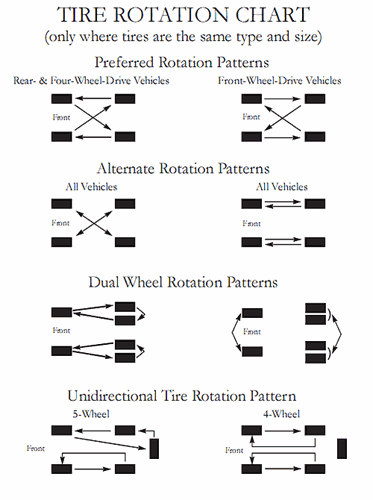
TIRE WEAR - VISUAL CHECK
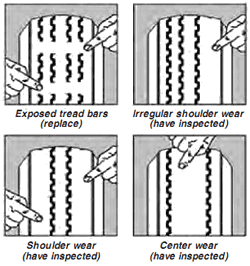
IMPORTANT to remember the following:
- These tire rotation recommendations do not take into account different tire types mixed on the vehicle. Do not mix radials and bias ply tires on the same vehicle.
- Some tires cannot be rotated in the manner described. Such tires include unidirectional tires. Unidirectional tread patterns must be rotated front-to-rear only so the direction of revolution does not change.
- Some vehicles are designed with a different tire sizes on the front and rear axles. Normally, such combinations will not allow rotation. Prior to rotating, consult the vehicle owner's manual.
- Vehicles with dual rear wheels – See the vehicle owner's manual for the vehicle manufacturer's procedures. If your vehicle owner's manual is not available, please contact the vehicle manufacturer.
- Some vehicles are equipped with wheels that limit the choice of rotation pattern. Consult the vehicle owner's manual.
- Do not include temporary spare tires in the rotation pattern. HOWEVER, if you have the same size and type road tire (for LT tires same size, type and Load Rating) as a spare tire, it should be included in the tire rotation process. The proper procedure is to use the vehicle manufacturer's recommended tire rotation procedures, or, if not available, use the appropriate rotation pattern shown, but insert the spare in the right rear position. Utillize the tire that would have gone to the right rear as the new spare.
- After rotation, adjust individual tire air pressure to vehicle manufacturer's recommendation or recommended air pressure by Toyo Tires for an optional fitment according to the tire's new location on the vehicle.
- Do not mix speed-rated tires on the same axle. Higher speed-rated tires must remain on the rear axle, or consult your authorized Toyo dealer.
TIRES MUST NEVER BE OPERATED IN EXCESS OF THEIR RATED SPEED LIMIT!
Regardless of the speed and handling capabilities of your car and its tires, a loss of vehicle control can result from exceeding the maximum speed: (a) allowed by law or (b) warranted by traffic, weather, vehicle or road conditions.
No tire, regardless of its design or speed rating, has unlimited capacity for speed. Exceeding the tire's speed capability will cause overheating and sudden tire failure, possibly leading to loss of vehicle control, which can cause an accident, including serious personal injury or death.
ALWAYS Observe Speed Limits - Never operate your vehicle in excess of lawful speeds or the maximum speeds justified by driving conditions.
EXPLANATION OF TIRE SPEED SYMBOLS

Many of today's tires are marked, as part of the service description, with letters to indicate their speed rating, based on laboratory tests that relate to performance on the road. Tires may be marked with one of these speed symbols: M, N, P, Q, R, S, T, U, H, V, W, or Y to identify the particular tire's speed rating. Additionally, the letter Z may appear in the size designation (see chart below)
When purchasing or replacing speed-rated tires, make sure to:
- Use the ranking in the chart below to compare the speed symbols of all the tires, and
- Follow the vehicle manufacturer's recommendations, if any, concerning the use of speed-rated tires.
To avoid reducing the speed capability of the vehicle, replace a speed-rated tire only with another tire having at least the same speed rating or higher speed-rated tire. Remember, it's the "top speed" of the "slowest" tire on the car, which cannot be exceeded without risk of tire failure. The letter symbols and corresponding design speeds are:
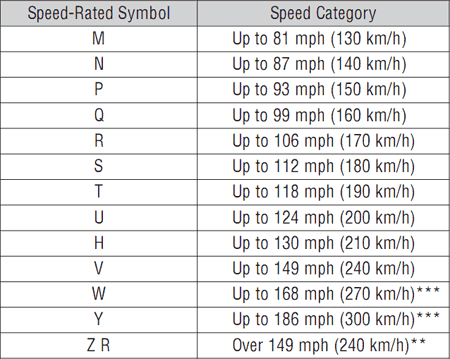
** Although no upper limit speed is specified, the indicated tires nonetheless have limited rated speed capability. Call (800) 442-8696 for a referral for more technical information.
*** Any tire with a speed capability above 149 mph (240 km/h) can, at the tire manufacturer's option, include a "Z" in the size designation (i.e. 245/40ZR18). If a service description IS NOT included, the tire manufacturer must be consulted for the maximum speed capability (P245/40ZR18 speed capability is greater than 149 mph {240 km/h}). If a service description is included with the size description, the speed capability is limited by the speed symbol in the service description {i.e. P235/45ZR17 97W = maximum speed 168mph (270 km/h)}.
These speed ratings are based on laboratory tests under specific, controlled conditions. Real-life driving is rarely identical to any test conditions. Your tire's actual speed capability may be less than its rated speed, since it is affected by factors such as inflation pressure, load, prior alteration or damage, driving conditions, alignment, wear, vehicle condition, and the duration for which high speed is sustained.
TIRE SPINNING CAN BE DANGEROUS
Spinning a tire to remove a vehicle stuck in mud, snow or wet grass can be dangerous. This could cause serious personal injury or death to a bystander or passenger and extensive vehicle damage. A tire spinning at a speedometer reading above 35 miles per hour (55 km/h) can, in a matter of seconds, reach a speed capable of disintegrating a tire with explosive force. Under some conditions, a tire may be spinning at a speed twice that shown on the speedometer. Never spin a tire above a speedometer reading of 35 mph (55 km/h). Never allow anyone to stand near or directly behind the spinning tire. Do not spin if a drive wheel is off the ground.
WARNING! THE FOLLOWING SITUATION CAN BE DANGEROUS:
Spin balancing a tire on the vehicle; at speeds exceeding a vehicle speedometer reading of 35 mph (55 km/h) [70 mph (115 km/h) if the tire is being balanced off of the vehicle or if the vehicle is equipped with a limited slip differential]; can be dangerous. The tire may fail with explosive force causing serious injury or death. Only trained personnel should spin balance tires. You should stand well away from the work area when tires are being spin balanced, either on or off the vehicle.
DO NOT OVERLOAD. DRIVING ON ANY OVERLOADED TIRE IS DANGEROUS!
The vehicle maximum load for your tire is critical and is marked on your tire's sidewall. Do not exceed these ratings. Follow the loading instructions of the manufacturer of your vehicle and this will ensure that your tires are not overloaded.
Tires that are loaded beyond their maximum allowable loads for the particular application will build up excessive heat that may result in sudden tire destruction. Reduction in tire inflation pressure will reduce the maximum load-carrying capacity of the tire. Vehicle load limits and special towing instructions are provided by the vehicle's manufacturer on the vehicle tire placard and in the owner's manual. When making alterations to your vehicle, or driving a vehicle with vehicle alterations, consult the vehicle manufacturer and the sidewall for the maximum load-carrying capacity of the tire. These alterations may cause different load requirements than were originally specified by the vehicle manufacturer. Do not exceed the gross axle weight ratings for any axle on your vehicle. Also, remember that the number of vehicle occupants and baggage carried on top or inside of the vehicle are additional loads.
Towing Considerations. If you anticipate towing a trailer, you should see your Toyo Tire dealer for advice concerning the correct size of tire and inflation pressures. Tire size and air pressure depend upon the type and size of trailer and hitch utilized but never exceed the maximum cold inflation pressure or the maximum tire load rating. The only sure way to prevent overload is to weigh each corner of the trailer in its fully loaded state. Check the tire placard on the vehicle and the owner's manual supplied by the manufacturer of your vehicle for further recommendations on trailer towing.
TAKE SPECIAL CARE WHEN DRIVING IN ADVERSE WEATHER CONDITIONS
- Driving in rain or snow considerably reduces the traction between your tires and the road surface. You must always reduce your speed to allow additional stopping distance between you and the vehicles ahead of you.
- Hydroplaning and wet weather driving - Hydroplaning occurs on wet roads and refers to the loss of tire contact with the road due to the buildup of water between the tire contact patch and the road surface. There are three main factors which affect hydroplaning, and consequently your tire traction on wet roads.
- Vehicle Speed. As speed increases, wet traction is considerably reduced.
- Water Depth. The deeper the water, the sooner your tires will lose traction. Even thin water layers can cause sufficient lubrication to cause traction loss at low speeds, depending on road conditions.
- Tire Tread Depth. As your tires wear down, their decreased ability to resist hydroplaning can result in complete loss of traction and vehicle control. You should always reduce speed with consideration to the traffic around you.
- Driving on ice and snow. Your all-season tires were designed to provide higher levels of snow traction compared to non-all-season tires. You have all-season tires if you find the letters "M&S" are molded into the sidewall near the bead. These letters mean "Mud and Snow." Tires designed for use in severe snow conditions generally have tread patterns, structure and materials to give superior performance. These tires are marked with the "M&S" designation plus a mountain/snowflake symbol. Even the best all-season tires will not provide acceptable levels of traction if you drive too fast in snow or ice conditions and if you do not allow for up to 12 times more stopping distance on icy roads compared to dry road surfaces. As is the case with hydroplaning, your ability to safely maneuver your car in snow or ice conditions is considerably reduced if:
- You are driving too fast for the road conditions.
- You do not allow sufficient stopping distance between your car and traffic in front of you.
- Your tires are too worn to provide adequate road grip.
TEMPORARY USE OF SPARE TIRES FOR SAFETY
The spare tire your car is equipped with may be of a different size and construction from the other tires on your vehicle. When using any temporary type spare tire, be sure to follow the vehicle manufacturer's instructions. FAILURE TO OBSERVE RECOMMENDED PRECAUTIONS COULD LEAD TO ERRATIC VEHICLE BEHAVIOR AND/OR TIRE DAMAGE, POSSIBLY RESULTING IN AN ACCIDENT.
- The temporary spare tire is designed for temporary use only. It must not be used as a standard tire continuously. The temporary spare tire should be returned to the trunk as soon as it is convenient to have your standard tire repaired or replaced.
- It should NOT BE used for speeds exceeding 50 miles per hour.
- NEVER use chains on temporary spare tires because it could cause damage to your vehicle.
- When you replace the temporary tire, replace it only with the same type of tire.
- Check inflation pressure before use. Failure to have proper inflation pressure when using your spare tire can result in serious personal injury or death. Maintain inflation pressure of 35psi for the temporary full size spare, and 60 psi for the "T" Type, high pressure, temporary spare tires. Always check inflation pressure before use. Failure to have proper inflation pressure when using your spare tire can result in serious personal injury or death.
- Placing (mounting) your temporary-use tire on a wheel which is not specifically designed for use with the temporary-use tire or placing another type tire on your temporary-use wheel can be dangerous. Your vehicle's handling characteristics can be seriously affected. You could have an accident resulting in serious personal injury or death. Consult your vehicle owner's manual for proper use of your "temporary use" spare tire.
- The "T" type, high-pressure, temporary spare tire should not be used with any other wheel nor should standard tires, snow tires, wheel covers or trim rings be used on the high pressure spare tire wheel.
- Do not operate your vehicle with more than one temporary spare in use (this does not apply to a full size spare), and only at limited speeds and distances as indicated on the sidewall of the tire. It is recommended to replace all ground tires at the same time.
TIRE STORAGE
Tires should be stored indoors in a cool, dry place where water cannot collect inside the tires. The tires should be placed away from electric generators, motors, and sources of heat such as hot pipes. Storage surfaces should be clean and free of grease, gasoline or other substances, which can deteriorate the rubber. Improper storage can damage your tires in ways that may not be visible and can lead to serious personal injury or death.
A full size spare tire in your vehicle is intended for use as a spare when needed. The spare tire carrier is not intended for long-term storage. Please see the section under "Tire Rotation" for the proper procedures to include the same size and type road tire (for LT tires of the same size, type and load rating) in the rotation pattern. (Do not rotate a temporary spare tire.)
SPECIAL ADVICE FOR LIGHT TRUCKS
Never exceed the speed limit as indicated by the speed symbol on the tire's sidewall. See chart and explanation of speed ratings in this manual on page 12.
Tires designated as "LT"
It is not recommended that any light truck be operated at speeds in excess of legal limits. However, if it is anticipated that sustained driving at speeds in excess of 65 miles per hour may be required, then the following adjustments or recommendations should be followed:
- At speeds from 66 mph through 75 mph, cold inflation pressure must be increased 10 psi above the recommended pressures for the load being carried.
- Do not exceed the maximum inflation pressure of the wheel (all wheels have maximum allowable inflation pressures).
- Non-speed rated "LT" designated tires should not be operated at speeds in excess of 85 miles per hour.
REPLACEMENT TIRES FOR LIGHT TRUCKS – P-METRIC VS. LT-METRIC
Tire installers should exercise extreme caution when replacing tires on light trucks. LT type tires (e.g. LT265/75R16) may not offer adequate load capacity when replacing P-metric type tires (e.g. P265/75R16), depending on the vehicle's load requirements and the tire's load/ply rating. LT type tires require much higher air pressures to carry equivalent loads of P-metric tires. If P-metric type tires are used to replace LT-metric tires, installers should verify the load requirement of the vehicle by checking the tire information placard. Always make sure that replacement tires offer equal or more load capacity (by inflation) compared to the originally installed tires. When a P-metric or metric tire is installed on a light truck (SUV, pickup, minivan), the load capacity (This load reduction factor is prescribed by Federal Motor of the tire is reduced by a factor of 1.10. Vehicle Safety Standards {FMVSS} and is based on the expectation that passenger type tires may. For example, experience more severe loading and usage conditions when applied to light trucks) 305/50R20 has a maximum load capacity of 3086 lbs. If this tire is fitted to a light truck, then the actual allowable load for the tire is 2805 lbs. (3086 lbs. Divided by 1.1). Consult manufacturer's load and inflation charts. Contact Toyo Technical Service with any tire replacement questions: 800-442-8696.
UNIFORM TIRE QUALITY GRADING (UTQG)
The Uniform Tire Quality Grading ("UTQG") standards are intended to assist you in making an informed choice in your purchase of passenger car tires by providing information indicating relative performance in the areas of tread wear, wet stopping traction, and temperature resistance. All passenger car tires must conform to federal safety requirements in addition to these grades.
- Treadwear
The treadwear grade is a comparative rating based on the wear rate of the tire when tested under controlled conditions on a specified government test track. For example, a tire graded 200 would wear twice as long on the government course as a tire graded 100. It is wrong to link treadwear grades with your projected tire mileage. The relative performance of tires depends upon the actual conditions of their use and may vary due to driving habits, service practices, differences in road characteristics and climate. - Traction
The traction grades, from highest to lowest, are AA, A, B, and C, and they represent the tire's ability to stop on wet pavement as measured under controlled conditions on specified government test surfaces of asphalt and concrete.
Warning: The traction grade assigned to tires is based on braking (straight ahead) traction tests and does not include cornering (turning) traction.
- Temperature
The temperature grades are A (the highest), B, and C, representing the tire's resistance to the generation of heat and its ability to dissipate heat when tested under controlled conditions on a specified indoor laboratory test wheel. Sustained high temperature can cause the materials of the tire to degenerate and reduce tire life, and excessive temperature can lead to sudden tire failure. The grade C corresponds to a level of performance, which all passenger car tires must meet under the Federal Motor Vehicle Safety Standard No. 109. Grades B and A represent higher levels of performance on the laboratory test wheel than the minimum required by law.
WARNING!
The temperature grade is established for a tire that is properly inflated and not overloaded. Excessive speed, underinflation, or excessive loading, either separately or in combination, can cause heat buildup and possible tire failure.
- DOT Quality Grades
All passenger car tires must conform to federal requirements in addition to these grades.
Remember, you are ultimately responsible for the tires installed on your vehicle.
If you have any further questions, contact your local Toyo Tire Dealer or Toyo Tire U.S.A. Corp. 1-800-442-8696